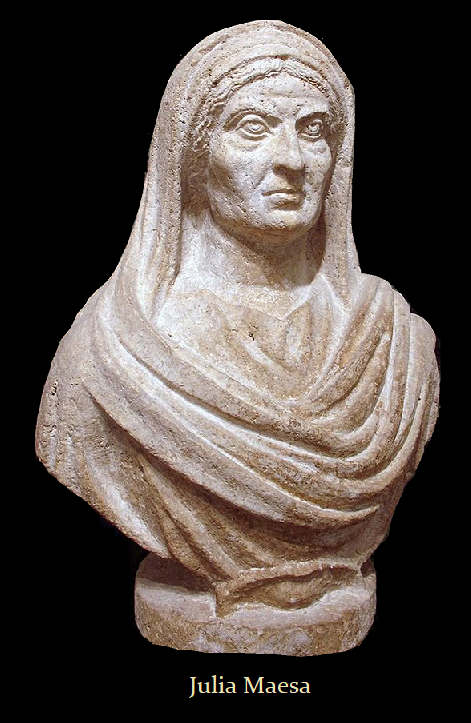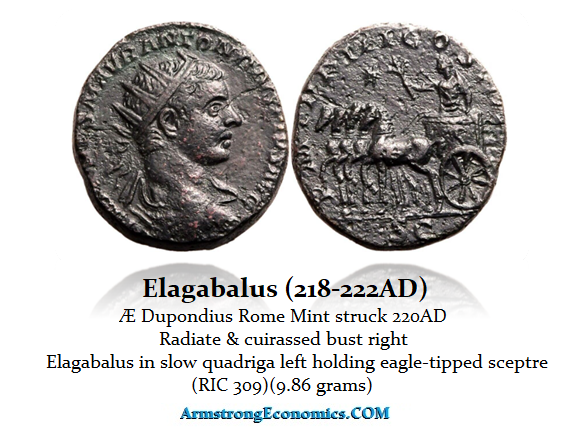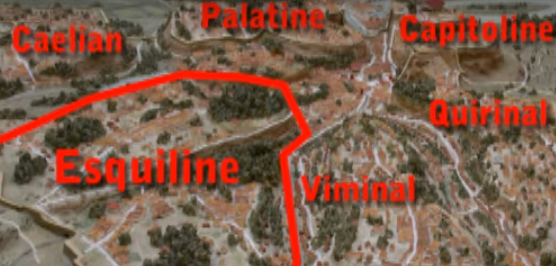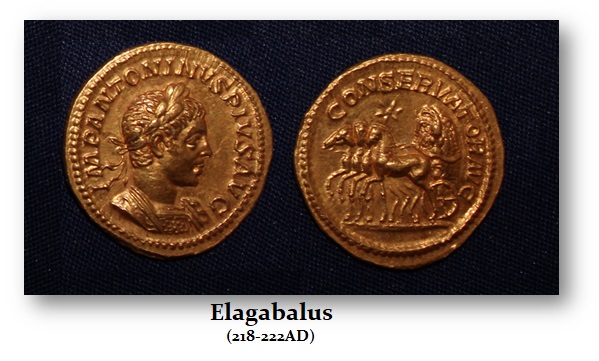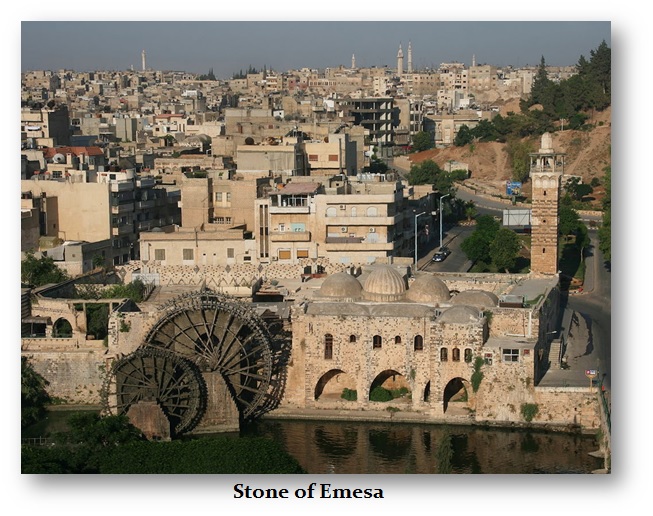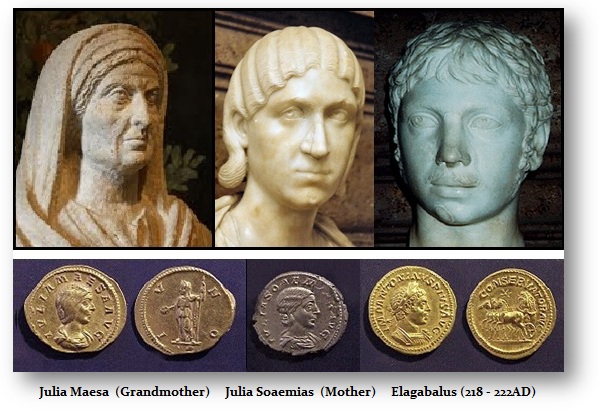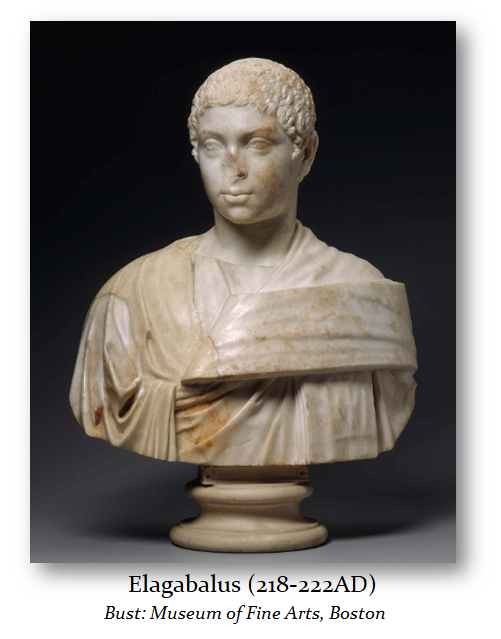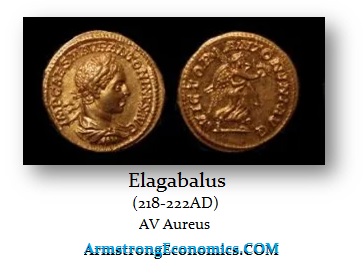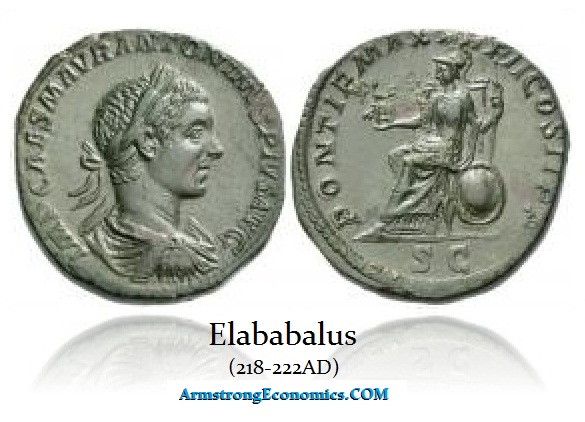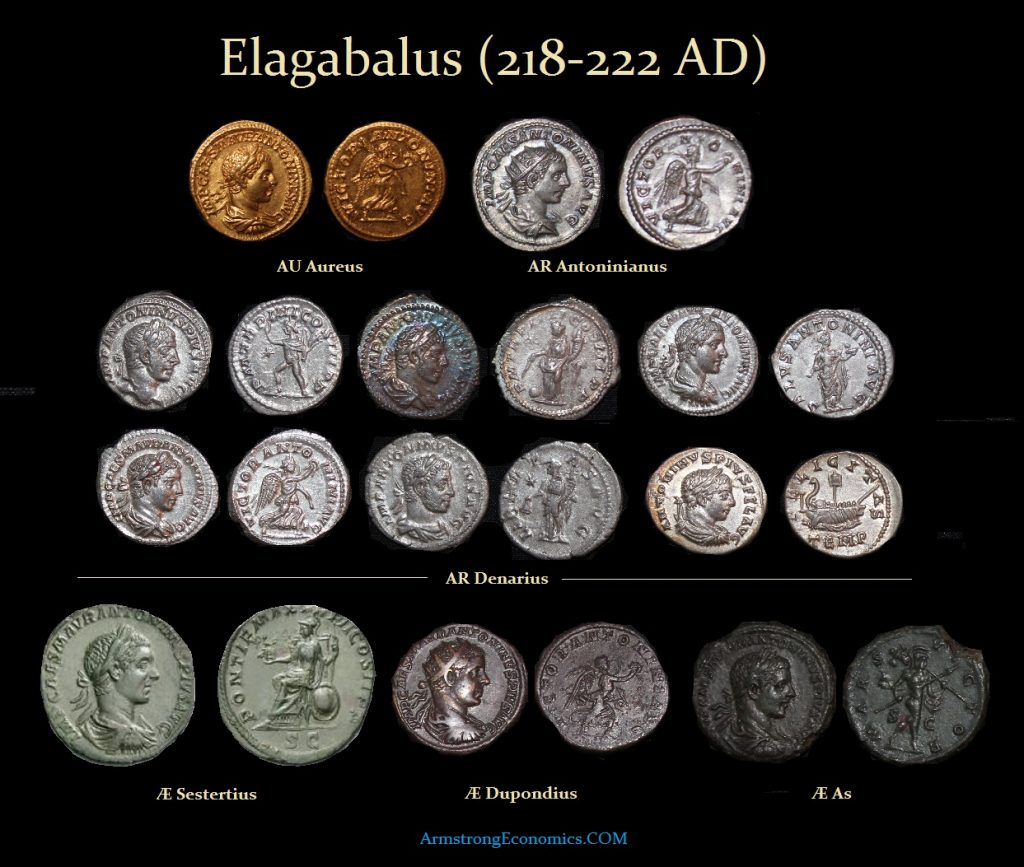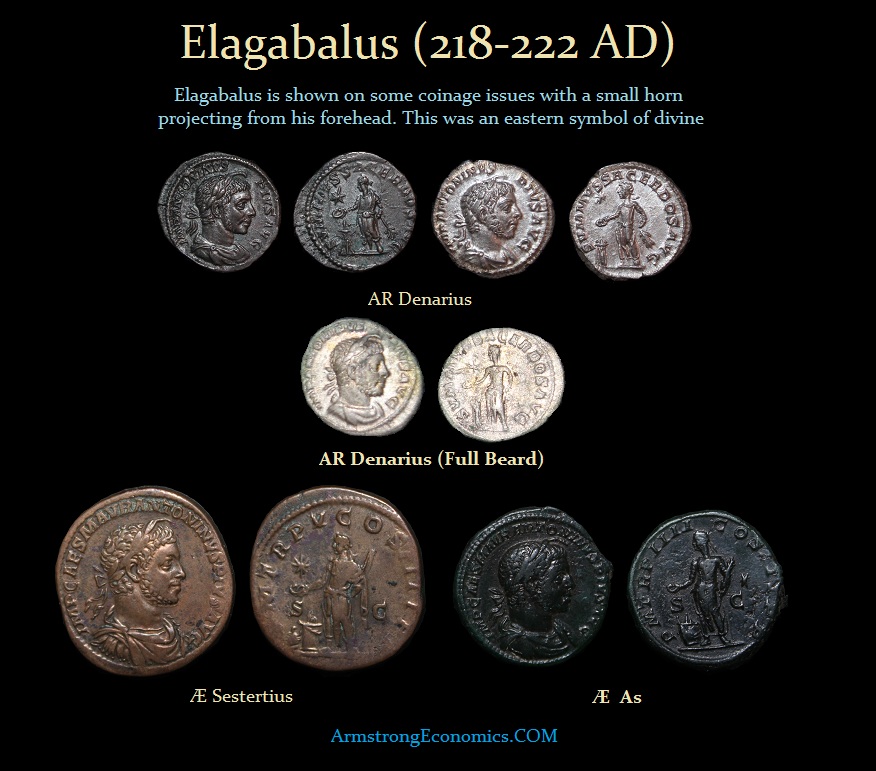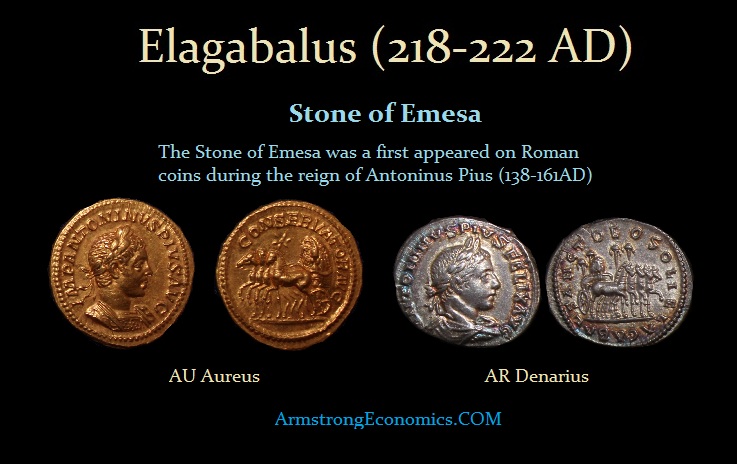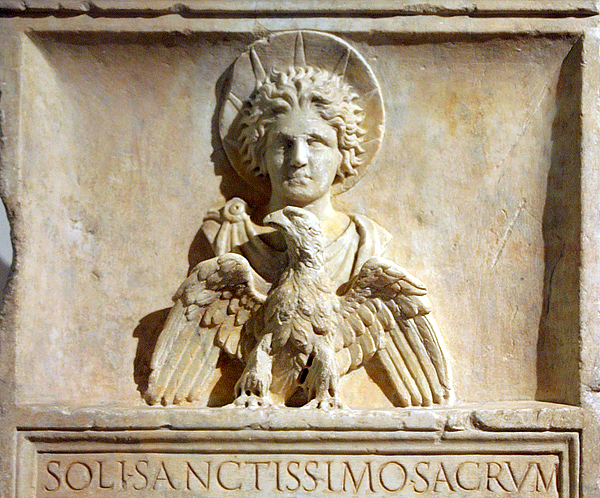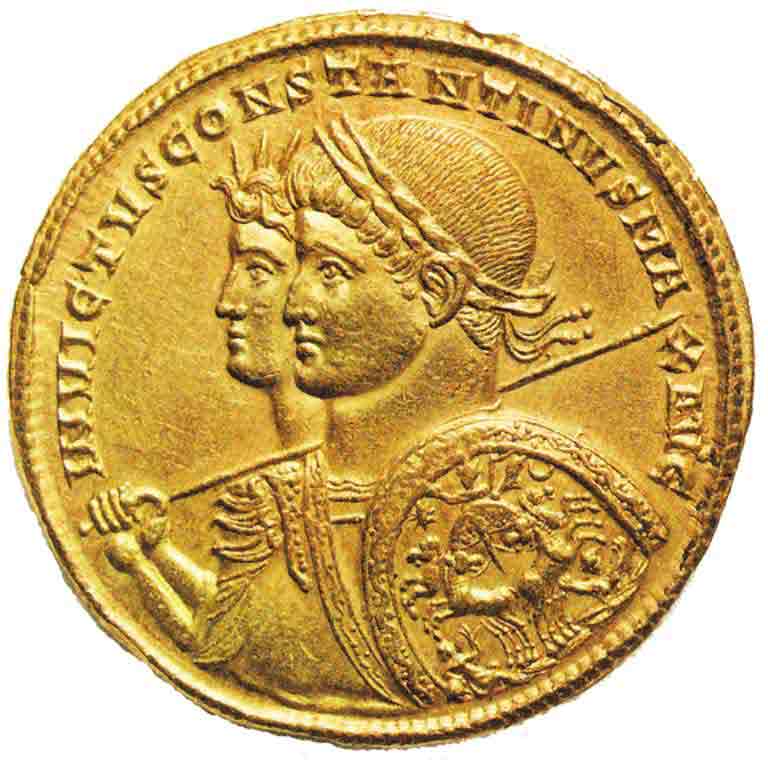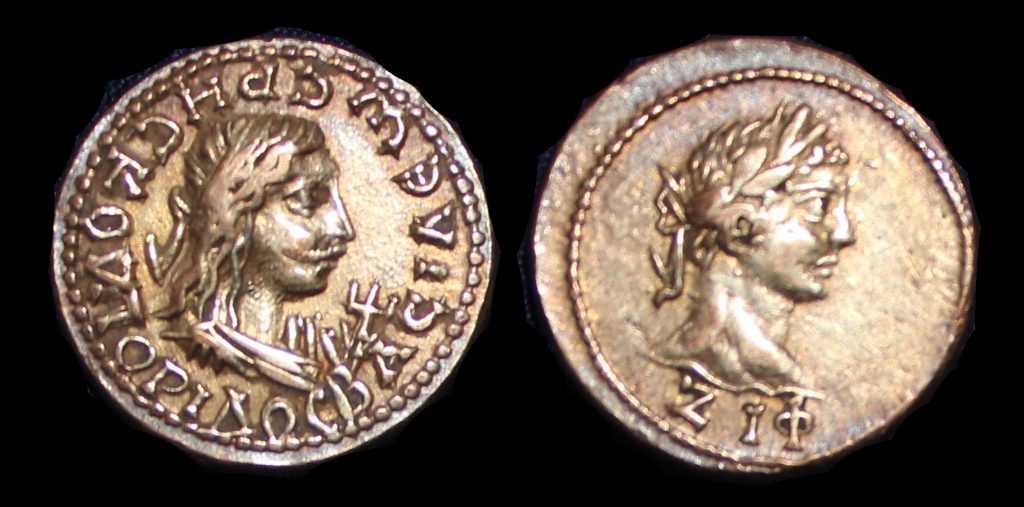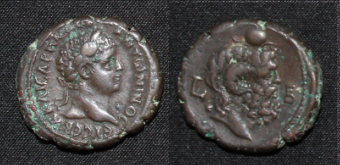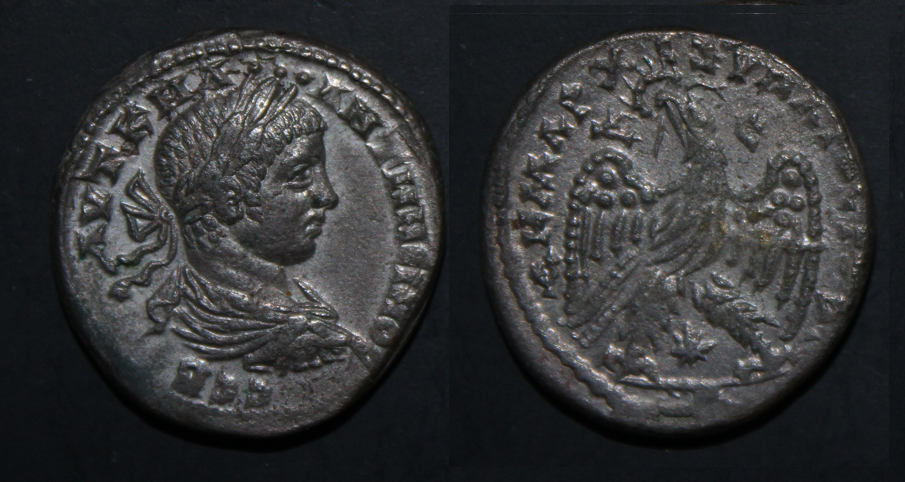Elagabalus
218-222 AD
The emperor known to history as Elagabalus takes his name from the sun god of Emesa, for which he was made a high priest on May 16th, 218 AD. Elagabalus was actually born about 205 AD as Varius Avitus Bassianus and later became known as “Marcus Aurelius Antoninus,” the formal name found in titles and on his coinage. Elagabalus was born at Emesa, the son of Sextus Varius Marcellus and Julia Soaemias, the daughter of Julia Maesa and grandson of the empress Julia Domna. He was related to Septimius Severus only through marriage but was the cousin of the emperor Caracalla.
With the assassination of Caracalla in 217 AD, power passed to the Praetorian Prefect Macrinus. At first, Macrinus made no threat against his mother, Julia Domna, who was living in Antioch at the time. Julia Domna, however, would not stay out of politics, and eventually, Macrinus was forced to order her to leave Antioch. Julia Domna refused and instead starved herself to death. She may have actually died of cancer. It is most likely that she was dying of cancer in any event.
The Severian women were very domineering, a trait that seems to have infected the entire family. Julia Domna’s sister was certainly no exception. Julia Maesa began to make her plans to grab power using her grandson Elagabalus in 217 AD. She managed to smuggle Elagabalus into the camp of the Third Legion in Syria, and by morning, she had convinced the troops that they should proclaim her grandson emperor of Rome.
Macrinus attempted to win back the loyalty of the troops by paying a donative. However, his recent reforms of the military made him very unpopular, and instead, he was forced to flee Antioch in a futile attempt to make it back to Rome. The rebels overtook Macrinus and executed him, as well as his son Diadumenian, who was attempting to flee to Parthia.
Thus began the reign of Elagabalus, who would become one of the most notorious emperors of Rome, sharing that distinction with Caligula, Nero, Commodus, and Caracalla before him. The Senate accepted Elagabalus as Emperor and began his journey to Rome in 219, departing from Nicomedia. In the year 220AD, lacking any real military skills or accomplishments, he issued a rare issue with him in a triumphant quadriga as a dupondius and an as with a horn obverse. The reverse has no particular propaganda announcement, just: P M TR P III COS III P P. He is known to have raced chariots, which was sort of like a president being the quarterback in the Superbowl.
Elagabalus developed the imperial palace at Horti Spei Veteris, which had the largest of the seven hills of Rime – the Esquiline Hill opposite the Palatine Hill, where emperor Augustus lived. He inherited this land from his father Sextus Varius Marcellus. Elagabalus made it his favorite retreat and designed it, perhaps in competition with Nero’s Domus Aurea project, a vast suburban villa. Caracalla constructed the Circus Varianus Hippodrome, but Elagabalus loved this circus and drove chariots inside the villa, which may be why this coinage showed him in his quadriga. Septimius Severus (193–211AD) built the first imperial residence in this area.
The Black Stone From God
Gold Aureus Stone of Emesa
When Elagabalus departed for Rome, he also took with him the famous black stone symbol of the sun-god Elagabalus from the temple at Emesa in Syria. Herodian described this Stone of Emesa as being rounded at its base and rising to a point at its top. There were a few rough projections in which people believed they saw an image of the sun. This black stone was most likely a meteor, lending its legend that it came from heaven as a gift from the god to mankind. Therefore, the role of the priest and the possession of this stone was of great symbolic power.
Elagabalus had been made a high priest of the sun-god cult when he was very young. The original temple was converted into a church, so it still stands. Both he and his mother were religious fanatics and went as far as to take their eastern god to reign over all Roman gods in Rome itself. He constructed a very large temple adjacent to the Colosseum on the Palatine Hill. A second temple was erected just outside of Rome. He and his family would walk backward in a procession before the stone as it was brought to the second temple outside of Rome during a midsummer festival.
Cassio Dio describes the sacrifices of both animals and young boys. They made it mandatory for all to worship at the Shine of the sun-god including Jews and Christians. The sun god was supreme, and all other gods were subordinate to it. His religious practices drew sharp criticism when, in 220 AD, Elagabalus divorced his first wife, Julia Paula, and took a Vestal Virgin as his wife – Aquilia Severa. Vestal Virgins had been buried alive for breaking their vows, even during the reign of Caracalla. Against the advice of his mother and grandmother, Elagabalus married Aquilia, arguing that a union between the high priest and priestess would produce a son of god. But this religious taboo led to so much outrage that Aquileia had to be divorced, and a third wife, Annia Faustina, was selected.
For all of Elagabalus‘ religious positions and many wives, he was also very notorious for being a bisexual who also enjoyed dressing up and playing the part of a woman. Cassio Dio tells us that Elagabalus even married a male slave named Hierocles and enjoyed being beaten by him as if he were Hierocles’ female slave and delighted in being called Hierocles’s mistress. Other men who slept with him were given high positions in government. Elagabalus wore makeup and wigs and preferred to be called a lady, not a lord. He is reported to have offered vast sums to any physician who could provide him with a vagina. We are unsure how far these stories go because he was so reviled. In this WOKE climate, in November 2023, the North Hertfordshire Museum in Hitchin, United Kingdom, given its extreme agenda, actually announced that Elagabalus would be considered to be TRANSGENDER, referring to him with female pronouns in its exhibits.
As such, respect for the state as a whole declined. Elagabalus even went as far as to ask doctors if they could medically transform him into a woman and carried out his own experiments by cutting off the gentiles of young men as a sacrifice to his sun god. Eventually, his disgusting sexual behavior led to the collapse in respect for him as an emperor. The totality of his behavior led to his loss of loyalty among the troops. Rebellions began as early as 218 AD when the Third Legion in Syria attempted a rebellion. This was followed by the Fourth Legion and later by the Roman Fleet. By 221 AD, his family convinced Elagabalus to adopt his cousin of 13, Severus Alexander, who was the son of his mother’s sister, Julia Mamaea.
Alexander clearly began to emerge as the favorite among the Praetorian Guard. Sometime in late 221, Elagabalus tried to order the death of Alexander, but no one would carry out the execution. Finally, on March 11th, 212 AD, when Elagabalus visited the Praetorian camp, he found open support for Alexander and tried to order the arrest and execution of those offenders. Instead, the soldiers refused, and Elagabalus tried to flee but was hunted down and murdered along with his mother. Thus, Severus Alexander was hailed as the emperor of Rome.
His reign was notorious for religious fanaticism, cruelty, bloodshed, and excesses of every description, and there was general satisfaction when, on March 6th, 222, Elagabalus and his mother, Julia Soaemias, were murdered in the praetorian camp. Their bodies were dragged through the streets of Rome and thrown into the Tiber.
Titles and Powers, 218-222 AD
Yr Tribunician Power Imp Consul Other
218 TR.P. IMP. I COS AVGVSTVS. P.M. P.P.
219 TR.P.II. COS.II.
221 TR.P.IIII.
220 TR.P.III. COS.III.
222 TR.P.V. COS.IIII.
Note: Elagabalus received the Tribunician Power on January 1st, 219 AD, and it was renewed each year on that date.
Tax Reform
A monetary crisis began to follow the civil war when Septimius Severus (193-211AD) came to power. He was forced to debase the silver denarius to about 50%-60% fine. The monetary crisis only worsened, and then his Caracalla introduced the double denarius, which was only about 1.5 denarii by weight. After murdering his own brother, Geta, refusing to share power, he was eventually assassinated and was followed by Macrinus (217-218AD). The entire stability of the monetary system was shaken to the very ground. Elababalus came to power, and the gold aureus weighed about 7.11 grams between 218-219AD. By 220-222AD, the weight fell to 6.4 grams and declined during these years to 6.08 grams. This was when Elagabalus ordered that all taxes be paid only in gold, rejecting silver entirely. The gold aureus began to rise in weight slightly back to about 6.5 grams.
Monetary System
Mints: Rome; Antioch (Other Eastern mints ?)
Obverse Legends:
ANTONINVS PIVS SAL AVG
IMP ANTONINVI AVG
IMP ANTONINVS PIVS AVG.
IMP CAES ANTONINVS AVG.
IMP CAES M AVR ANTONINVS AVG
IMP CAES M AVR ANTONINVS PIVS AVG
Portrait Styles:
The double denominations of the Antoninianus and Dupondius were still denoted by a portrait of the emperor wearing a radiate crown. All other denominations depict the emperor with a laureate wreath. On some later issues, Elagabalus is depicted with a small horn projecting from his forehead. This was an Eastern symbol of divine power.
DENOMINATIONS
AU Aureus (6.54 grams)
AU Quinarius (4.61 grams)
AR Antoninianus (=2 denarii)
AR Denarius
AR Quinarius
Æ Sestertius
Æ Dupondius
Æ As
Horned Bust of Elagabalus
A small horn projection from the forehead, some believe, was an Eastern symbol of divinity. In contrast, others have argued that it is a dried bull’s penis, a symbol of potency (Krengel, 53-72).
AU Aureus (6.54 grams)
AR Denarius
Æ Sestertius (Orichalcum)
Æ As (Copper)
Stone of Emesa Issues
AU Aureus (6.54 grams)
AR Denarius
Note: The earliest appearance of the Stone of Emesa on coinage is attributed to a Roman Provincial coin of Emesa issued by Antoninus Pius (138-161AD), Æ 23mm (9.69 grams). Laureate head right / Eagle, holding wreath in beak, standing right, head left, on baetyl of El-Gabal; Δ to the right. Emesa was the major cult center for the deity El-Gabal, who was worshipped there as a baetyl, a large black conical meteorite. It was seen as a stone sent from the Sun god. Some sixty years after Pius’ death, the teenage priest of the god Varius Avitus Bassianus (Elagabalus) became emperor and moved the baetyl meteorite to Rome. By his decree, for a brief period, the Stone of Emesa became the principal deity in the Roman pantheon. Upon the assassination of Elagabalus, his successor, Severus Alexander, sent the baetyl meteorite back to Emesa.
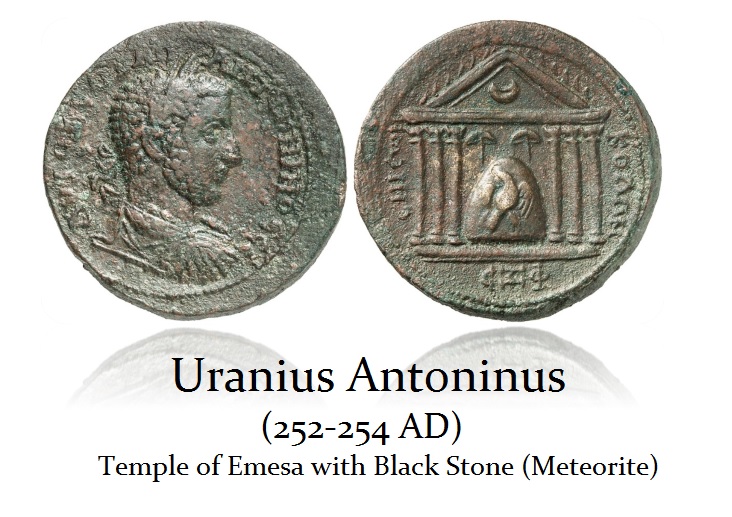 Once again, we see the Black Meteorite, Stone of Emesa, still worshiped there in the region of Syria, for it appears again on the coinage of the usurper Julius Aurelius Sulpicius Uranius Antoninus (252-254AD), who rose to power also claiming to be a priest-king. He successfully defended Emesa against the Persian invasion led by Shapur I in 253AD.
Once again, we see the Black Meteorite, Stone of Emesa, still worshiped there in the region of Syria, for it appears again on the coinage of the usurper Julius Aurelius Sulpicius Uranius Antoninus (252-254AD), who rose to power also claiming to be a priest-king. He successfully defended Emesa against the Persian invasion led by Shapur I in 253AD.
The cult of El-Gabal saw a resurgence in Rome under Aurelian (270-275 AD); he wisely promoted the worship of the deity in an iconic form more acceptable to Westerners, showing a human form with a radiated crown of sunbeams. This also became the source for the Statue of Liberty, which had the same radiated sunbeams from her head. The eastern god of Sol was probably adopted by tradition from the Sun god of Egypt.
We find Sol appearing on Roman coins post-Aurelian. The most significant use of Sol was actually employed by Constantine the Great once again for strategic political purposes. Sol tended to replace most of the Roman gods and the Greeks as the barbarian invasions became more aggressive following the capture of Valerian I by the Persians in 260AD. Constantine argued that there was one god and only one emperor should exist. Sol Invictus became the motto, and his feast day was December 25th, which they selected for the birth of Jesus Christ.
COLONIAL
Bosporus
Electrum Stater Bosporos (Rheskuporis II & Elagabalus)
EGYPT
Æ Tetradrachm (13.64 grams)
SYRIA
AR Tetradrachm (13.17 grams)


